
It started last night in earnest, making me wish there was an Earnest, Minnesota, so people could say that the snow began to fall in Earnest, and it would be a geographical fact, not a cliche employed by lazy writers. I figured it would “taper off,” as they say, in the night - but I woke to a sight so magical I wished I’d said “awoke,” which is more Clement-Mooresque, and would excuse the use of the word “magical.”
Let me start again.
So winter is a thing. Here’s 21 animated gifs to make you feel the winter love but no cats rocking a shovel. We has a sad
AUUUGH! I dreamed I was a Buzzfeed intern! And was prefacing the description of a nocturnal reverie with a Charlie Brown vocalization!
Let me start again.
It snowed all night. When I went down the stairs I looked out the window on the landing, and saw the slender branches of Tree Number Two piled high with frosting, two inches at least. It was perfect December snow, heavy and wet, falling with such speed and volume that you knew it was laying down the Permanent Pack. This was snow that would last; this was snow that rewrote the plot entirely. Before there was bare brown lawns and dry streets and the general miserable ache of a cold dry December, with all the carols and lights and TV shows and cards-in-the-mail making it look like we were going through the motions, sleepwalking through The Holidays because the calendar had commanded that we do so.
But this. This was Christmas snow. This was miracle-snow, happy-day-at-the-orphanage sledding snow, Tiny-Tim waving his now-discarded crutch snow, old man who had lost faith in humanity feeling the spirit of the season snow. It was the greatest loudest C-major chord had been struck and it would take an entire day to diminish.
So. Better shovel. I have a service that does the miles of sidewalk at Jasperwood, but they hadn’t come yet, and my wife needed to go to the Mall. So I scraped out a path. This is Widowmaker snow, as we call it - the thick stuff that gives men a coronary as they hoist and toss. In the middle of the job the guys showed up to plow, and while they did a fine job, the snow continued to come down with such speed that I had to do it again three hours later - at which point I realized to my dismay that the Jackwad who plows an adjacent alley had piled up a ridge in the middle of the street.
I shoveled the street. Three hours later I went out and shoveled again, working on the pile the city plows would shove into our driveway, thinking: oh, dammit. What a strange life to spend so much time rearranging precipitation.
But that was just part of it. Mostly I just admired it with great happy gratitude. It reminded me of one of the first storms we got when we moved here, when Christmas in the new house was just as perfect as it could possibly be, and I was agog at the beauty of this place. (Those are pix I took on Sunday.)
Jasper loves it; dogs love snow. He went out and sat in the snow and I wonder if the cold doesn’t sooth the ache in his old bones. He went for a walk tonight and shoved his muzzle into the drifts to interrogate the secrets now buried beneath.
My wife put the ramp away, the one he used to get up and down the back steps; he doesn’t use it anymore. Sometimes he makes it up. Sometimes he just barks from the foot of the stairs and I carry him up. That’s been normal for a while.
I’ve known a few old dogs in my life, but haven’t lived with any. Usually old dogs at a friend’s house - grouchy, suspicious beasts that pad around and sniff you and walk off and spend the day on their side, staring into the fog. Jasper spends most of his days snoozing, but after his walk tonight he was convinced, absolutely certain, that there was Imminent Meat, and kept walking around the house, waiting for the meat to be deployed. At one point he became impatient with it all, sat in the middle of the kitchen, and barked at us. Spent the meal pacing the table, waiting for a plate to lick. Around ten PM he wanted to go outside, and went to the back door and looked up at me: again? If you could?
I carried him down the stairs. He walked out to the edge of the backyard. I saw him standing in the penumbra of the Christmas lights, snout up, sniffing the world. I wonder what it smells like to him. Whether it’s interesting because it’s cold, or interesting because it’s a song that has one note. One note he’d never heard before, and knew right away.
We all felt that way today.

Spent some time this weekend with an enormous 48-pound book:
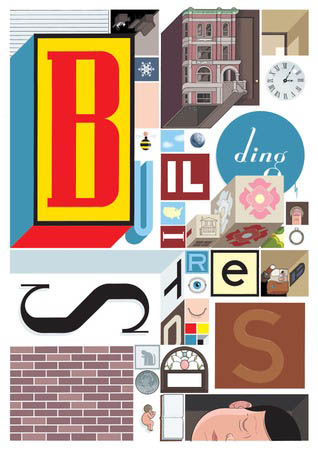
Okay, maybe not 48 pounds. It’s quite the project. I bought it because it’s by Chris Ware, and I still have the tiny thin little Acme Novelty Library I bought at an Uptown comic store in 1994:
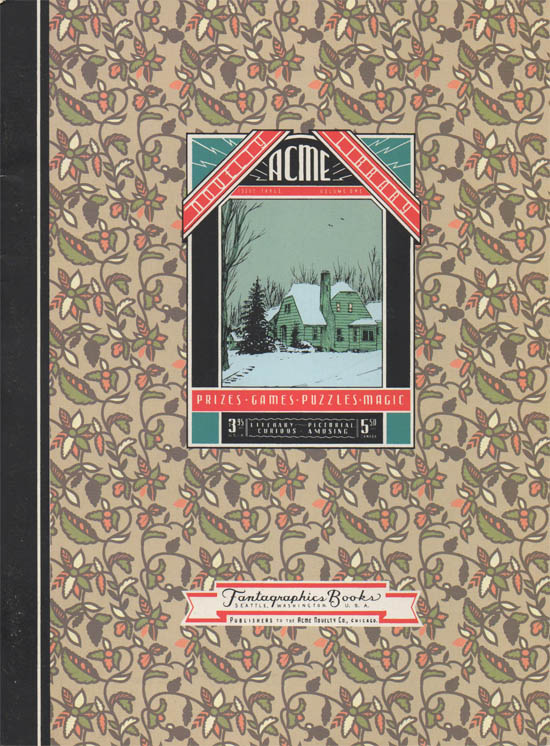
It's about a strange little potato-shaped man and his grumpy dog. No stories, as such; no punchlines, as we understand them; no dialogue. What really impressed me - and suggested that this fellow shared a wavelength - was the back cover.

All the items shown are things you could afford if you didn't have to feed children. It's pretty funny. It is, of course, this:

So, I thought, here's a guy who grew up with the same stuff - and has a great love for the previous styles of the 20th century as well. And an amazing skill at typography and page composition. I found the two previous Acme Novelty Library books, and began a long acquaintance with his work. I’ve bought everything since.
It’s impossible to have a series of Chris Ware books on your shelf. They come in different sizes and shapes, some of which are so tall you cannot put them on any bookshelf. They earn their size; he uses every inch. Drives me nuts. You know, pal, consistent sizes were okay with Herge. He managed. You ever told a story as involved as a Tintin tale? No, right, you’re the guy who patented the page with 126 panels where an old woman notes a fly and we think, man, life is a constant mix of internal self-castigating prattle, self-justification, quotidian details, and the eventual recognition of the ordinary, freighted with pathos and banality.
I’m serious: one of last pages of a "Buildng Stories" book consists of an old woman having apple slices and noticing a fly. The fly is there. And then the fly is gone.
Life's like that, you know. What with the flies and the passage of time and the sense of futility we push away by thinking about things like lunch.
So it's either over-praised pretentious twaddle, an empty thing into which people pour meaning the author declines to provide, or it really is storytelling in the most economical form possible, a few simple images distilling everything said about the character in the previous pages. I go with the latter, of course, because it makes me feel better to praise this as the culmination of his style than to say “we’ve seen this about 20 times before, in one form or another.”
let me complain some more. The new opus, Building Stories, comes in a box. Inside the box is a series of printed books, a tidy pyramid that starts with a thin collection of strips about a mother’s years with her daughter - ending with a series of images that almost stops your heart, if it’s true, if it’s what you think. There’s an early Acme-Novelty-Series sized chapbook about Brandford Bee, done in Ware's “circle” style, rerunning all of his themes, except in Bee form. Then a Little Golden Book about the character we’ve met before - the young depressed woman who has a prosthetic leg, and lives in the Building, with a cat. Janine Corrigan, if you want, but not as funny. Not funny at all.
Janine Corrigan, then: just as lonely and maladjusted, but real in a way Jimmy never was. Complicating our reaction: there’s nothing about her to like. She’s neither this or that. She’s a lump. (There’s one section where she has the things she wanted when she was miserable, and she’s still unhappy; Ware does a nice job of sending up liberal eschatology, unless he’s serious and trying to send a message; hard to say, given the brilliantly composed but intellectually facile attempts at political commentary he's done.) If I had to define a reaction to her character, it would be boredom and impatience; if I had to guess why the author chose to devote so much time on such a nebbish, I couldn’t, apart from the artistic challenge of describing the grinding anomie of young adulthood.
Chris Ware books used to have several flavors blended together: hilariously awful depressing; depressing; sharply cynical and hilarious. His parody ads - ranging from the 20s to the 70s - were brilliant. Jimmy Corrigan, the Smartest Kid on Earth, is one of the most depressing things you’ll ever read, but it contained a dark hilarity when the episodes were read over the course of a few years. Condensed in one large magnificent book, the humor fades. Rusty Brown in short one-page strips: a comic masterpiece. Rusty Brown in story form: put-a-ginzu-in-your-gut-and-rip-upward pathos. The “Building” sequence, so far, is almost completely humorless, and every single page feels like a thumb pressing on your heart.
There were two characters in the Oughts he’s dropped: Big Tex and Rocket Sam. The latter was a 30s-style astronaut marooned on a planet with a robot he made. Big Tex was a moron, hated by his cruel father. (In one strip, his dad takes him out to teach him to shoot a gun, but has him dig a grave first.) Ware used the “Gasoline Alley” Sunday strip style for this story, which pretty much sums up Big Tex’s life.
I wanted Big Tex to be happy. I wanted Rocket Sam’s robot to be happy. I don’t care about these characters, because they don’t want to be happy. They want to be pitied, and since no one’s around to pity them, they pity themselves - when not engaging in tedious, trite existential monologues. (Which they know are trite, which makes them all the more bored and disappointed with themselves.)
Ware knows all this; he knows that’s how it’s going to look to his worst critics. Hence, stickers like this, so small you cannot read them without putting them close to your face in a bright light:
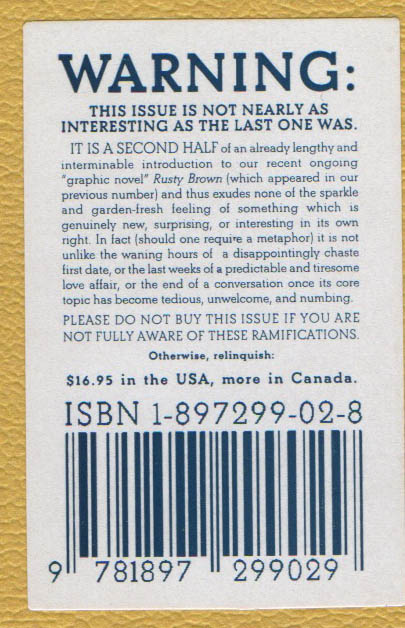
The style: at this point you could say Ware has stopped growing as an artist, and he’d probably say Yes, That Is My Fear. The insistence on ornate forms for the work masks an obvious inability to progress beyond the isometric, spare style he’s been using for years, like a composer who has no new themes but scores his new symphony for unusual instruments and hopes no one notices.
Then again, the last Tintin book looks a lot like the first Tintin book. No one composes a page like Ware, and while that might be a trick to make you ascribe more meaning to the page than the page actually provides, it makes every turn of the page a revelation.
You might think that this mannered style is all he can do: no. The cover of the Rusty Brown book that has the warning sticker is a perfect 1960s school textbook:

The title page, which has nothing to do with that style or the style of the book, but instead shows Rusty Brown in a Golden Books style that appears nowhere else, ever:
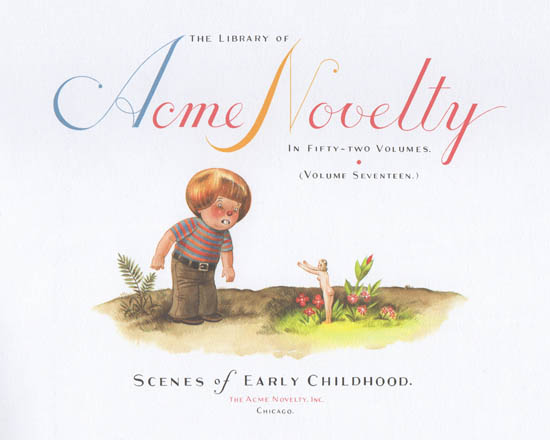
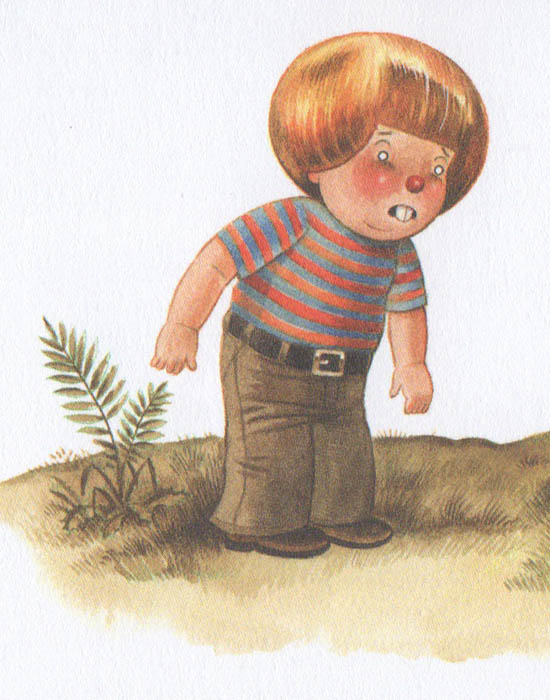
Just scroll up and down this page again. That's the same guy.
So there you are: The art is the same. The themes are the same. The characters are the same. It weighs more and has different-sized books. Nothing really happens. “Building Stories” is seven pounds of hurt.
I can't recomend it enough, because it's Chris Ware. When I finished it, though, I was glad to be shot of the thing. I was glad to be done with her. The title of the project is misleading, alas. If the compendium was really about the building where the few main characters live, there would be more about the others who’d lived there - it’s a marvelous dramatic opportunity. Instead we follow the life of someone with no particular qualities, and leave the Building behind; the end sequence concerns the death of Janine Corrigan’s friend, and her cat, and also a mouse whose clumsy obvious metaphorical intentions are underlined by Janine noting how it’s a crappy metaphor, and hence god hates her.
But then, you think, well, that’s how people like her would see such a thing. Overanalyze, look for the metaphors, chew themselves up for thinking these parallels were profound.
It’s true; it’s real. Doesn’t make it interesting.
There is an aching spiritual vacancy in the work that the author seems to recognize in himself, and cannot ignore, and cannot fix. (In terms of the story: Branford Bee with a sheet of Hard Air between himself and God.) Everything about his work suggests the futility of attempting to fix it, because the self is stuck in the attic we furnish with memory and failure. What was previously profound about his work - the excruciations of loneliness, the implacable idiocy of time, the pleasures and tortures of self-awareness - ends up wasted on a character who joins his pantheon of unfortunates without adding anything distinctive.
Chris Ware is a great artist. "Building Stories" is good but it is not great. He will do great things in the future. I will buy them.